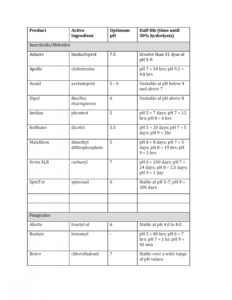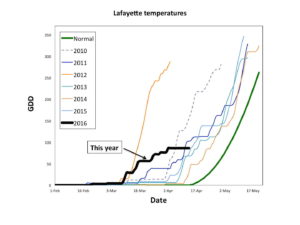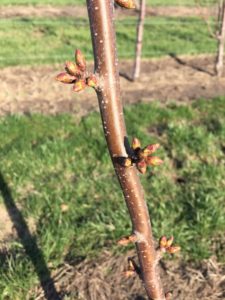The 2016 Midwest Fruit Pest Management Guide (ID-465) is available for purchase from the Purdue Education Store. This publication replaces two previous annual publications: The Midwest Tree Fruit Spray Guide (ID-168) and The Midwest Small Fruit and Grape Spray Guide (ID-169). This guide provides pest management recommendations for commercial tree fruit, small fruit, and grape[Read More…]
As the spray season approaches, it is good to remember the profound impact water quality has on the performance of pesticides used by fruit growers. Purdue Pesticides Program recently published a guide, The Impact of Water Quality on Pesticide Performance PPP-86, available at the Education Store, 1-888-EXT-INFO or www.extension.purdue.edu/store/. I highly recommend this guide to[Read More…]
There are some potential pest and disease problems that require early season sprays. Phomopsis is a major problem on many grape varieties in the Midwest. Mancozeb should be applied starting at 1-3 inch shoots and repeated each 7-10 days, especially prior to a predicted rain event. Colleagues in Michigan and Ohio have been conducting evaluations[Read More…]
Early spring is a good time to make the first herbicide application of the year. There are several options for grapes, brambles and blueberries including both pre and post-emergent herbicides. In most situations, there will be some emerged weeds present in the planting at this time of the year. That means a post-emergent herbicide will[Read More…]
The proper time to remove straw from matted row strawberries is when the bare-soil temperature at 4 inches averages about 40-43˚F. This usually coincides with mid to late March in central Indiana. This year is earlier than average with temperatures well into the 50s already by March 15. Plants will begin pushing new leaves as[Read More…]
Spring freeze damage can be a significant economic problem for Midwest grape growers. Widespread damage occurred in 2007 and 2012 when warm temperatures in March were followed by freezing temperatures in April. Obviously this year we have had a warm February and March so it is very possible that we will have early bud break[Read More…]
March is a good time to finish pruning summer-bearing brambles. Last years fruited canes should be removed now if they were not removed last summer or fall. Remove weak or spindly floricanes and thin to 4-6 canes per foot of row. Laterals on blackberries and black and purple raspberries should be trimmed back to about 2/3[Read More…]
The most important spray of the season for control of anthracnose on brambles is the delayed dormant spray of lime sulfur, Sulforix or copper hydroxide. If you have a problem with anthracnose, this is one spray that you can’t afford to miss. One of these materials should be applied when new leaves are exposed 1/4[Read More…]



